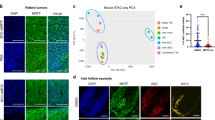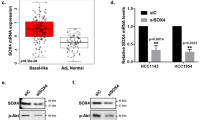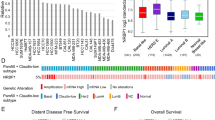Abstract
Growth of basal cell carcinomas (BCCs) requires high levels of hedgehog (HH) signalling through the transcription factor GLI1. Although inhibitors of membrane protein smoothened (SMO) effectively suppress HH signalling, early tumour resistance illustrates the need for additional downstream targets for therapy1,2,3,4,5,6. Here we identify atypical protein kinase C ι/λ (aPKC-ι/λ) as a novel GLI regulator in mammals. aPKC-ι/λ and its polarity signalling partners7 co-localize at the centrosome and form a complex with missing-in-metastasis (MIM), a scaffolding protein that potentiates HH signalling8,9. Genetic or pharmacological loss of aPKC-ι/λ function blocks HH signalling and proliferation of BCC cells. Prkci is a HH target gene that forms a positive feedback loop with GLI and exists at increased levels in BCCs. Genome-wide transcriptional profiling shows that aPKC-ι/λ and SMO control the expression of similar genes in tumour cells. aPKC-ι/λ functions downstream of SMO to phosphorylate and activate GLI1, resulting in maximal DNA binding and transcriptional activation. Activated aPKC-ι/λ is upregulated in SMO-inhibitor-resistant tumours and targeting aPKC-ι/λ suppresses signalling and growth of resistant BCC cell lines. These results demonstrate that aPKC-ι/λ is critical for HH-dependent processes and implicates aPKC-ι/λ as a new, tumour-selective therapeutic target for the treatment of SMO-inhibitor-resistant cancers.
This is a preview of subscription content, access via your institution
Access options
Subscribe to this journal
Receive 51 print issues and online access
$199.00 per year
only $3.90 per issue
Buy this article
- Purchase on Springer Link
- Instant access to full article PDF
Prices may be subject to local taxes which are calculated during checkout




Similar content being viewed by others
References
Ng, J. M. Y. & Curran, T. The Hedgehog’s tale: developing strategies for targeting cancer. Nature Rev. Cancer 11, 493–501 (2011)
Yauch, R. L. et al. Smoothened mutation confers resistance to a Hedgehog pathway inhibitor in medulloblastoma. Science 326, 572–574 (2009)
Buonamici, S. et al. Interfering with resistance to smoothened antagonists by inhibition of the PI3K pathway in medulloblastoma. Sci. Transl. Med. 2, 51ra70 (2010)
Dijkgraaf, G. J. P. et al. Small molecule inhibition of GDC-0449 refractory smoothened mutants and downstream mechanisms of drug resistance. Cancer Res. 71, 435–444 (2011)
Chang, A. L. S. & Oro, A. E. Initial assessment of tumor regrowth after vismodegib in advanced basal cell carcinoma. Arch. Dermatol. 148, 1324–1325 (2012)
Atwood, S. X., Chang, A. L. S. & Oro, A. E. Hedgehog pathway inhibition and the race against tumor evolution. J. Cell Biol. 199, 193–197 (2012)
St Johnston, D. & Ahringer, J. Cell polarity in eggs and epithelia: parallels and diversity. Cell 141, 757–774 (2010)
Bershteyn, M., Atwood, S. X., Woo, W.-M., Li, M. & Oro, A. E. MIM and cortactin antagonism regulates ciliogenesis and hedgehog signaling. Dev. Cell 19, 270–283 (2010)
Callahan, C. A. et al. MIM/BEG4, a sonic hedgehog-responsive gene that potentiates Gli-dependent transcription. Genes Dev. 18, 2724–2729 (2004)
Aszterbaum, M. et al. Ultraviolet and ionizing radiation enhance the growth of BCCs and trichoblastomas in patched heterozygous knockout mice. Nature Med. 5, 1285–1291 (1999)
Atwood, S. X. & Prehoda, K. E. aPKC phosphorylates Miranda to polarize fate determinants during neuroblast asymmetric cell division. Curr. Biol. 19, 723–729 (2009)
Standaert, M. L. et al. Insulin activates protein kinases C-ζ and C-λ by an autophosphorylation-dependent mechanism and stimulates their translocation to GLUT4 vesicles and other membrane fractions in rat adipocytes. J. Biol. Chem. 274, 25308–25316 (1999)
Winklmayr, M. et al. Non-consensus GLI binding sites in Hedgehog target gene regulation. BMC Mol. Biol. 11, 2 (2010)
Wang, G. Y. et al. Establishment of murine basal cell carcinoma allografts: a potential model for preclinical drug testing and for molecular analysis. J. Invest. Dermatol. 131, 2298–2305 (2011)
Lee, E. Y. et al. Hedgehog pathway-regulated gene networks in cerebellum development and tumorigenesis. Proc. Natl Acad. Sci. USA 107, 9736–9741 (2010)
Vokes, S. A., Ji, H., Wong, W. H. & McMahon, A. P. A genome-scale analysis of the cis-regulatory circuitry underlying sonic hedgehog-mediated patterning of the mammalian limb. Genes Dev. 22, 2651–2663 (2008)
Vokes, S. A. et al. Genomic characterization of Gli-activator targets in sonic hedgehog-mediated neural patterning. Development 134, 1977–1989 (2007)
Po, A. et al. Hedgehog controls neural stem cells through p53-independent regulation of Nanog. EMBO J. 29, 2646–2658 (2010)
Kim, J. et al. Itraconazole, a commonly used antifungal that inhibits Hedgehog pathway activity and cancer growth. Cancer Cell 17, 388–399 (2010)
Kim, J., Lee, J. J., Kim, J., Gardner, D. & Beachy, P. A. Arsenic antagonizes the Hedgehog pathway by preventing ciliary accumulation and reducing stability of the Gli2 transcriptional effector. Proc. Natl Acad. Sci. USA 107, 13432–13437 (2010)
Little, A. S. et al. Amplification of the driving oncogene, KRAS or BRAF, underpins acquired resistance to MEK1/2 inhibitors in colorectal cancer cells. Sci. Signal. 4, ra17 (2011)
Atwood, S. X., Chabu, C., Penkert, R. R., Doe, C. Q. & Prehoda, K. E. Cdc42 acts downstream of Bazooka to regulate neuroblast polarity through Par-6 aPKC. J. Cell Sci. 120, 3200–3206 (2007)
Meigs, T. E. & Kaplan, D. D. Isolation of centrosomes from cultured Mammalian cells. Cold Spring Harb. Protocols 10.1101/pdb.prot5039 (2008)
Acknowledgements
We would like to thank K. Qun for bioinformatics assistance, J. Kim for archival BCC tissue, A. Chang and S. Aasi for clinical trial operations, K. Chang for technical assistance, and H. Chang and P. Khavari for reading the manuscript. This work was supported by NIH NRSA 1F32CA14208701 (S.X.A.) and NIH grants AR052785 and AR046786 (A.E.O.).
Author information
Authors and Affiliations
Contributions
S.X.A. and A.E.O. designed the experiments. S.X.A. performed the experiments. M.L. aided the biochemical and knockdown analyses. A.L. and J.Y.T. performed the allograft BCC drug treatments. J.Y.T. provided vismodegib-resistant tumour samples. S.X.A. and A.E.O. wrote the manuscript.
Corresponding authors
Ethics declarations
Competing interests
A.E.O. is a clinical investigator for trials funded by Genentech and Novartis.
Supplementary information
Supplementary Information
This file contains Supplementary Figures 1-8 and Supplementary Table 1. (PDF 3830 kb)
Rights and permissions
About this article
Cite this article
Atwood, S., Li, M., Lee, A. et al. GLI activation by atypical protein kinase C ι/λ regulates the growth of basal cell carcinomas. Nature 494, 484–488 (2013). https://doi.org/10.1038/nature11889
Received:
Accepted:
Published:
Issue Date:
DOI: https://doi.org/10.1038/nature11889
This article is cited by
-
Advances in glioma-associated oncogene (GLI) inhibitors for cancer therapy
Investigational New Drugs (2022)
-
GLI3: a mediator of genetic diseases, development and cancer
Cell Communication and Signaling (2020)
-
AP-1 and TGFß cooperativity drives non-canonical Hedgehog signaling in resistant basal cell carcinoma
Nature Communications (2020)
-
Lineage-specific roles of hedgehog-GLI signaling during mammalian kidney development
Pediatric Nephrology (2020)
-
Clinical significance of atypical protein kinase C (PKCι and PKCζ) and its relationship with yes-associated protein in lung adenocarcinoma
BMC Cancer (2019)
Comments
By submitting a comment you agree to abide by our Terms and Community Guidelines. If you find something abusive or that does not comply with our terms or guidelines please flag it as inappropriate.



